Impressionist Art Romantisism Erea What Year Was Starry Night Created
From a painting that was supposedly merely a written report of a starry night to becoming an overnight awareness by an artist who is immortalized and remembered for cutting off his own ear. This is of form the beloved Vincent van Gogh, who painted The Starry Night (1889). In this commodity, nosotros will discuss this painting in more than item by looking at why it was painted and the stylistic elements that have kept it swirling in all our memories.
Table of Contents
- 1 Creative person Abstract: Who Was Vincent van Gogh?
- two The Starry Night by Vincent van Gogh in Context
- two.1 Contextual Assay: A Brief Socio-Historical Overview
- 3 Formal Analysis: A Brief Compositional Overview
- three.1 Subject area Matter
- 3.2 A Matter of Swirls: Color and Lite
- 3.iii Perspective and Space
- three.4 Symbolism and Fashion
- 3.5 Not to Be Confused With the Other Starry Night
- iv Reaching for the Stars
- v Frequently Asked Questions
- 5.1 Who Painted The Starry Night?
- 5.2 Where Was The Starry Night Painted?
- 5.3 How Many Starry Night Paintings Are There?
- 5.iv Where Is The Starry Dark Painting Housed?
- v.v How Much Is The Starry Dark Worth?
Creative person Abstract: Who Was Vincent van Gogh?
Vincent Willem van Gogh was born on 30 March 1853 in kingdom of the netherlands. He attended a couple of boarding schools during his youth and worked as an art dealer at Goupil & Cie from 1869. Van Gogh was not a successful artist and had a mentally challenging life. Although his art developed as he matured every bit an artist, he even so had diverse occasions where he was admitted to psychiatric hospitals. After a stint with Paul Gauguin, van Gogh likewise cutting a office of his ear off. He sadly committed suicide on 27 July 1890 by shooting himself in the breast and only dying more than 24 hours afterward.
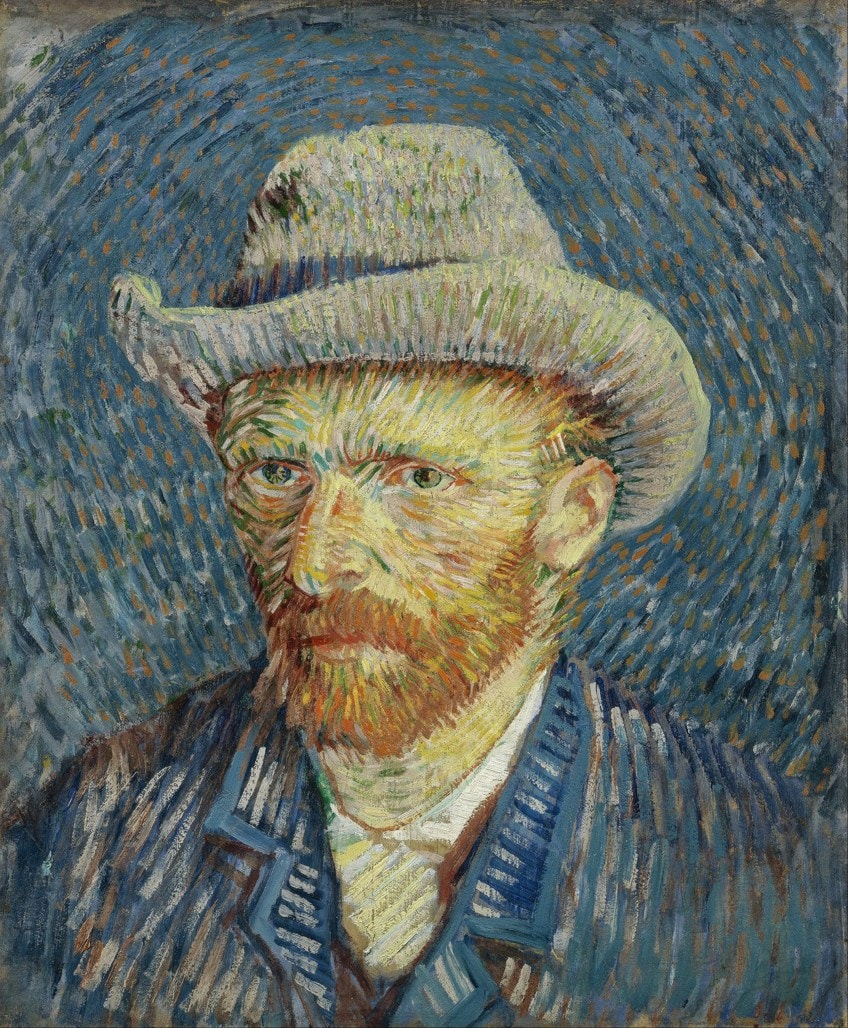 Cocky-portrait with grey felt hat (1887) past Vincent van Gogh; Vincent van Gogh, Public domain, via Wikimedia Eatables
Cocky-portrait with grey felt hat (1887) past Vincent van Gogh; Vincent van Gogh, Public domain, via Wikimedia Eatables
The Starry Nighttime by Vincent van Gogh in Context
Although Vincent van Gogh was not a famous creative person when he was alive, he left a legacy of artwork few, if any, tin compare with. The Vincent van Gogh paintings collection is infused with the depth of his emotional, mental, and spiritual inner earth. He was what nosotros telephone call a "tortured" artist and experienced considerable inner turmoil.
His art depicts bright and colorful landscapes and objects with expressive and dynamic brushstrokes.
Below we volition explore how van Gogh brought his inner dimensions to life on his canvases, namely the painting The Starry Dark (1889). We will first look at a contextual analysis and where van Gogh was at the time of painting this starry night. We will as well discuss how van Gogh fit into the Postal service-Impressionist movement of the fourth dimension.
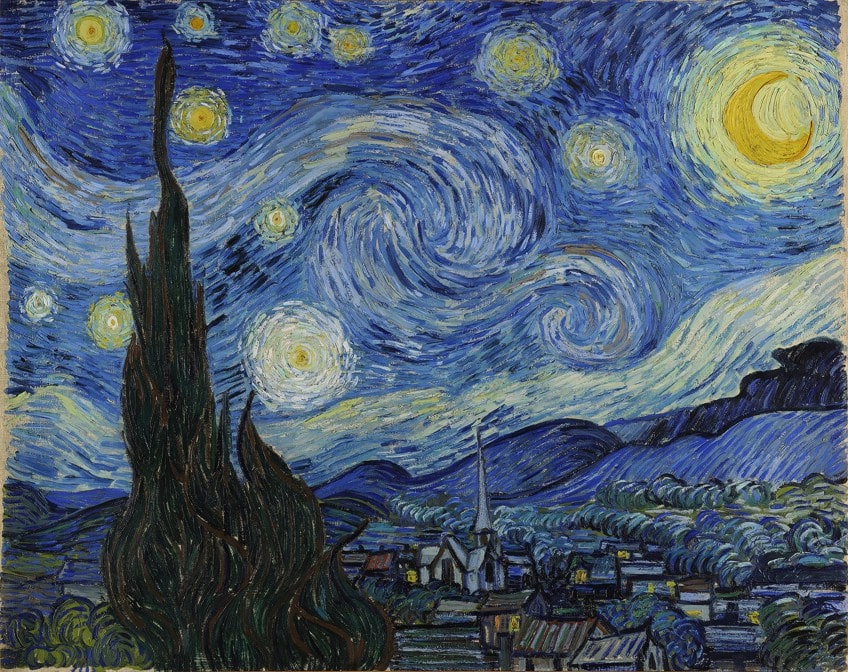 The Starry Nighttime (1889) by Vincent van Gogh; Vincent van Gogh, Public domain, via Wikimedia Eatables
The Starry Nighttime (1889) by Vincent van Gogh; Vincent van Gogh, Public domain, via Wikimedia Eatables
Lastly, we will provide a formal analysis of The Starry Night painting and identify a scope view on the creative person'south utilization of color, form, and perspective. In that location is a lot happening and swirling in his iconic painting and all of information technology adds to The Starry Night's meaning. So, let us await farther.
| Artist | Vincent van Gogh |
| Date Painted | 1889 |
| Medium | Oil on canvas |
| Genre | Landscape |
| Period / Motility | Post-Impressionism |
| Dimensions | 73.7 x 92.1 centimeters |
| Series / Versions | Nocturne Series |
| Where Is Information technology Housed? | The Museum of Modern Art |
| What It Is Worth | The worth is estimated to exist over $100 million |
Contextual Analysis: A Brief Socio-Historical Overview
When van Gogh painted The Starry Night in 1889, he was staying in the Saint-Paul-de-Mausole mental aviary in Saint-Rémy-de-Provence in the southern parts of France. The preceding events leading upwardly to his access to the hospital were quite tumultuous and involved a confrontation with his acquaintance and boyfriend Mail-Impressionist painter Paul Gauguin, and van Gogh cutting off a part of his own ear. He reportedly experienced a severe psychotic break after these events and would have various more.
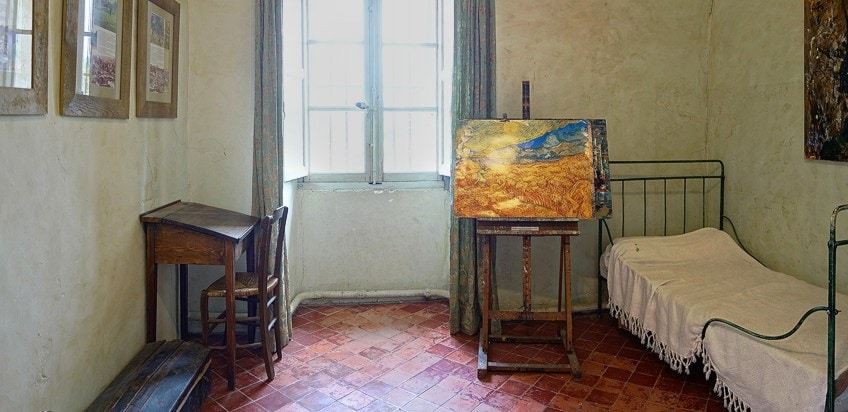 Van Gogh'southward bedroom at the Saint-Paul-de-Mausole mental asylum in Saint-Rémy-de-Provence; Velvet, CC BY-SA iv.0, via Wikimedia Eatables
Van Gogh'southward bedroom at the Saint-Paul-de-Mausole mental asylum in Saint-Rémy-de-Provence; Velvet, CC BY-SA iv.0, via Wikimedia Eatables
During his stay he had two rooms, ane was a sleeping accommodation, and 1 was utilized as a painting studio. His subject matter was of the asylum and its surrounding gardens, although he was able to move around more than than almost of the other patients. His room, which was apparently east-facing, had a view of the French Alpilles mountain range, which inspired a lot of his landscapes.
However, his painting studio did not accept a view of the mountains, but it is believed van Gogh painted a lot from memory, imagination, and other artworks.
A Little Bit More than Most Post-Impressionism
During the 1880s, several artists moved away from the realists' approach of painting from nature and the world every bit they saw information technology. This arroyo is referred to equally en plein air , which means "outdoors" in French. The Impressionists focused on portraying the real aspects of life and non so much the depiction of the more traditional and classic subject matter nosotros see from Renaissance paintings.
Colors and brushwork were more than expressive and artists were non focused on the type of stylistic elements like symmetry, gild, and form. It is oftentimes described as an optical form of art considering artists focused on how they perceived the natural globe and painted information technology accordingly. One of the leading figures during this new and revolutionary modern period of art was Claude Monet.
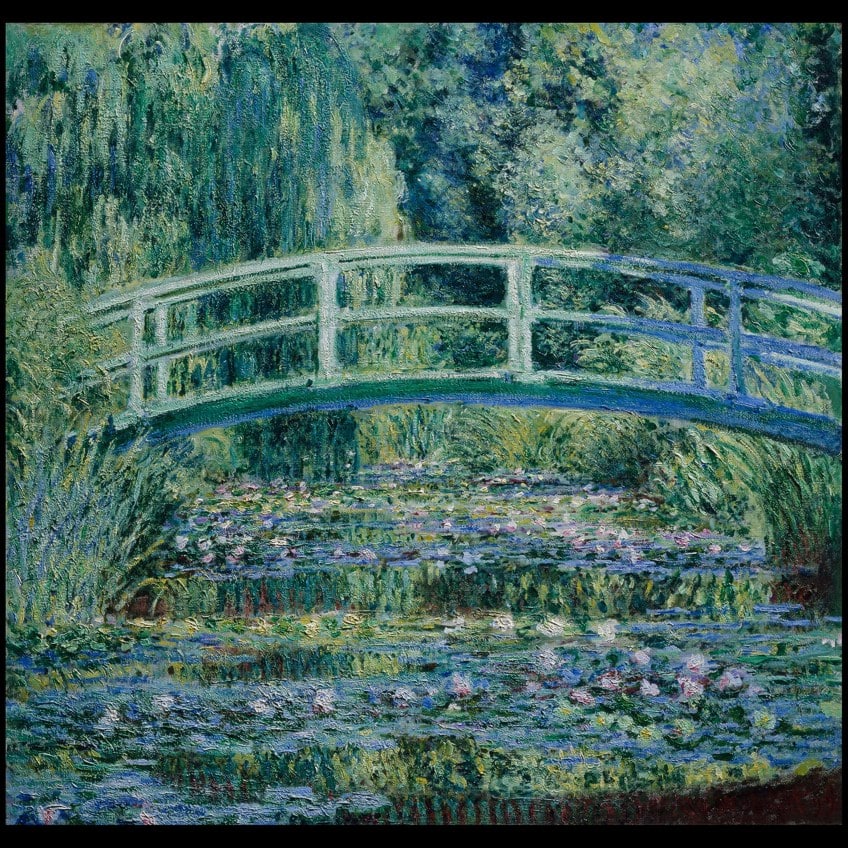 Water Lilies and Japanese Bridge (1899) by Claude Monet;Claude Monet, Public domain, via Wikimedia Commons
Water Lilies and Japanese Bridge (1899) by Claude Monet;Claude Monet, Public domain, via Wikimedia Commons
There was no one set of rules for Mail-Impressionists, which followed directly after, as they all approached their fine art in unlike means and styles. Still, a mutual thread was that artworks were generally more than abstruse and symbolic, not as focused on trying to depict the natural surroundings as the Impressionists were. Some artists like Paul Cézanne focused on how compositions relied on primal forms as he stated, "Care for nature in terms of the cylinder, the sphere, the cone".
Artists like Paul Gauguin and van Gogh depicted their subject field affair rooted in more emotional perspectives and symbolism.
Gauguin developed a style called Synthetism, which referred to the "synthesis" of all the influencing elements of what makes the artwork. This includes the formal qualities of colors and lines, the external subject thing, and the subjective feelings of the creative person, and as mentioned before in the instance of van Gogh, can be derived from imagination and memory.
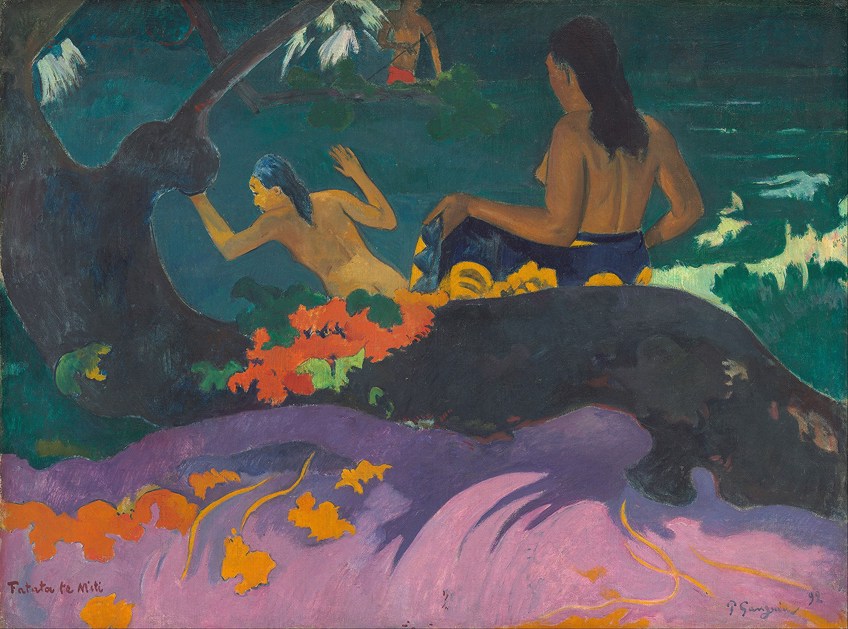 Fatata te miti ( By the Bounding main) (1892) past Paul Gauguin; Paul Gauguin, Public domain, via Wikimedia Commons
Fatata te miti ( By the Bounding main) (1892) past Paul Gauguin; Paul Gauguin, Public domain, via Wikimedia Commons
Paris, the Yellowish House, and a Severed Ear
Equally per van Gogh's invitation to join him, he and Paul Gauguin worked closely together in the French city called Arles during the 1880s. They rented and worked in the aforementioned space, which was referred to every bit the "Yellowish House", for a couple of months. Van Gogh moved to Arles from Paris.
Whilst in Paris, he lived with his blood brother Theo for a while and acquainted himself with the art society in that location. He as well held and participated in several exhibitions.
Interestingly, during van Gogh's time in Paris, he met several important figures from the Impressionist movement, namely, Edgar Degas, Claude Monet, Camille Pissarro, and Georges Seurat. These artists besides influenced van Gogh's style and, obviously, he utilized a lighter colour scheme every bit a outcome.
Back to the Yellow House. This motion was part of van Gogh'south goal to start a new customs for artists in Arles, including his desire to have Gauguin at that place to be a part of information technology. Information technology was Gauguin's unique way and utilise of different colors from when he lived in Martinique that inspired both Vincent and Theo van Gogh who saw these paintings after Gauguin'due south return to Paris.
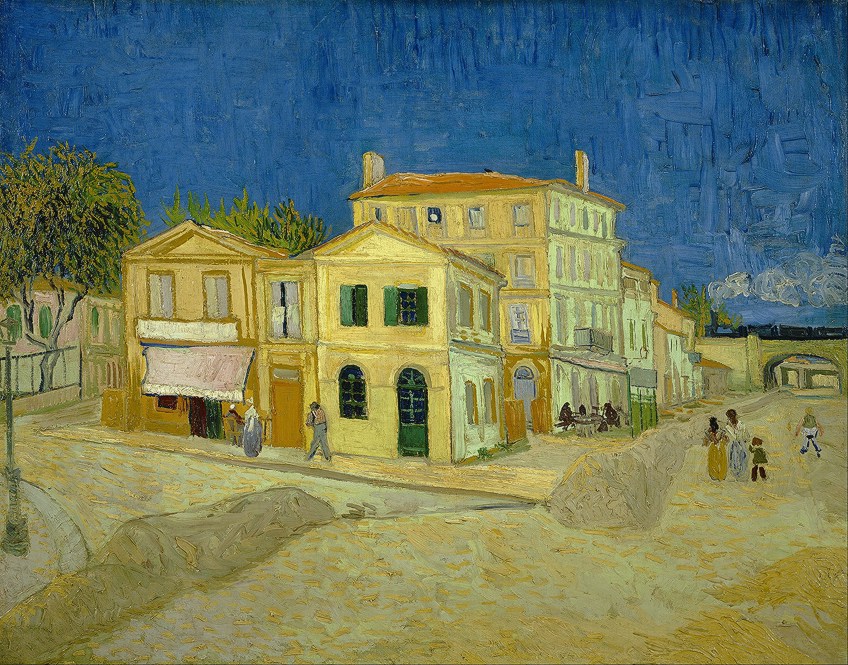 The yellow business firm ('The street') (Arles, 1888) by Vincent van Gogh;Vincent van Gogh, Public domain, via Wikimedia Eatables
The yellow business firm ('The street') (Arles, 1888) by Vincent van Gogh;Vincent van Gogh, Public domain, via Wikimedia Eatables
The paintings were reportedly at the habitation of Gauguin'due south acquaintance, Émile Schuffenecker. The brothers bought 1 of these paintings called The Mango Trees (1887) and a few other works and drawings. Importantly, Theo van Gogh became Gauguin's art dealer and contributed to his artistic success in Paris. It is also believed that Gauguin'south venture to Martinique could take inspired Vincent van Gogh to also leave the urban center to find another place of artistic inspiration – in this example, Arles.
It was a tumultuous partnership between Gauguin and van Gogh considering the artists were quite different in their styles.
Withal, the two shared artistic visions and are believed to have explored the expression of emotions through the use of different colors, a feature we are all aware of with both artists' works. From Gauguin's autobiography Avant et aprè (1903), he is quoted every bit stating that the two artists created a large body of artworks during their collaborative menses, "unbeknownst to the public, two men achieved in that period a jumbo amount of work, useful to both of them. Perhaps to others equally well?" Thought to be Vincent van Gogh (third from the left, with pipe) in chat with Paul Gauguin, Émile Bernard, Félix Jobbé-Duval. André Antoine is standing between them. Bearding photograph, 1887; Fifty'artauprésent, CC Past-SA 4.0, via Wikimedia Eatables
Thought to be Vincent van Gogh (third from the left, with pipe) in chat with Paul Gauguin, Émile Bernard, Félix Jobbé-Duval. André Antoine is standing between them. Bearding photograph, 1887; Fifty'artauprésent, CC Past-SA 4.0, via Wikimedia Eatables
The two artists did in fact attain a "colossal amount of work", reportedly creating over 50 works collectively. Simply, sadly, their differences interrupted them and whatever happened between the ii, Gauguin ended upwardly leaving the xanthous firm and van Gogh severed part of his ear.
This brings us full circle again to the events of van Gogh's stay at Saint-Paul-de-Mausole.
He apparently voluntarily admitted himself. His bouts of mental disruptions could have been part of the reason why it became difficult for Gauguin to remain at the house. However, the ii acquaintances are remembered to have remained in touch with one another through writing letters; Theo van Gogh also continued supporting Gauguin as an creative person through his work as an art dealer.
Theo van Gogh
Theo van Gogh is worth mentioning here because he was an of import person in Vincent van Gogh's life, not only because the two were brothers – Theo was younger than Vincent – but he too provided considerable financial support to Vincent too as advice and guidance on diverse matters.
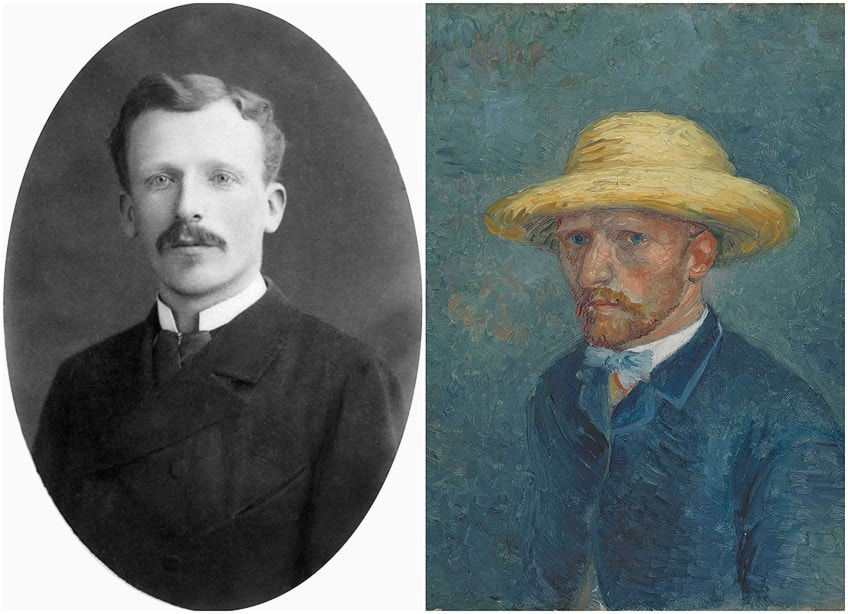 LEFT: A photograph of Theo van Gogh, c. 1888; Public Domain, Link | RIGHT: Portrait of Theo van Gogh (1887) by Vincent van Gogh; Vincent van Gogh, Public domain, via Wikimedia Commons
LEFT: A photograph of Theo van Gogh, c. 1888; Public Domain, Link | RIGHT: Portrait of Theo van Gogh (1887) by Vincent van Gogh; Vincent van Gogh, Public domain, via Wikimedia Commons
Because Theo was an fine art dealer, some may wonder how much is The Starry Dark worth and where is The Starry Nighttime painting at present? However, this painting was handed over to Theo when Vincent died and eventually became part of the drove of the Museum of Modern Art in New York in 1941 through the art dealer Paul Rosenberg.
A lot of what we know about Vincent van Gogh'due south artwork and life comes from around 600 letters betwixt him and his brother, although he did write other letters to acquaintances such every bit Paul Gauguin, Émile Bernard, and Anthon van Rappard.
These messages were compiled into a book, published in 1914, past Theo'due south wife, Johanna van Gogh-Bonger after the two brothers' deaths.
Formal Analysis: A Cursory Compositional Overview
Below we explore van Gogh'due south, The Starry Night further, kickoff, we will look at what exactly we are looking at in this swirling nightscape of colors and brushstrokes, which will lead united states of america on to discuss van Gogh's stylistic elements like his employ of color and technique.
Subject Matter
Let us outset with the foreground, to the lower-left corner we meet a dark cypress tree reaching upwards into the sky, information technology has been likened to long flames reaching upwards. We see the height tendril nestling itself in-between some of the big yellow orbs of stars in the heaven.
Similarly, we can also notice the long spiral of the church building situated in the center footing of the composition. This is echoed with the cypress tree in the foreground.
Looking at the middle footing, we run across what appears to be a pocket-sized village, the said church equally the primal focal betoken. To the right, the hamlet is flanked by a hilly area that flattens out from the right to the left side of the composition.
An interesting fact most the village is that it was believed to be created from van Gogh's imagination, perhaps from sketches done of Saint-Rémy. Some sources also advise it could accept been from his memories of where he grew upwards, such every bit the church building steeple resembles churches from Holland and manifestly not churches found in French republic.
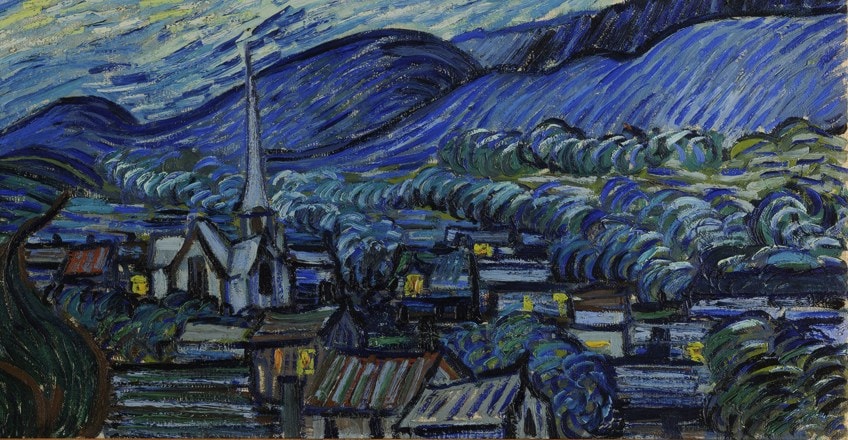 A item of The Starry Dark (1889) by Vincent van Gogh; Vincent van Gogh, Public domain, via Wikimedia Commons
A item of The Starry Dark (1889) by Vincent van Gogh; Vincent van Gogh, Public domain, via Wikimedia Commons
The foreground and middle ground make upwards almost one-third of the painting, with the other 2-thirds making up the vast expanse of blues that make the night heaven. The manner van Gogh depicted the dark sky is brilliant and quite light; it is not a dark evening. This is undoubtedly the consequence created by the moonlight and light from the stars, which appear as pulsating shining orbs of light. In fact, van Gogh emphasized their polish with auras of yellows and whites, merely nosotros will get to his color scheme further beneath.
We see around 11 stars in the heaven with the crescent moon brightly shining, near similar a sun, in the acme correct corner. The dark sky is lit up, giving us a clear view of the unabridged hamlet and surrounding landscape.
A Thing of Swirls: Colour and Light
Vincent van Gogh'southward The Starry Night is a matter of swirls, and this is what makes his composition, and emphasizes the subject matter. There is meaning dynamism in The Starry Night, created from the thick application of brushstrokes in flowing and circular lines.
Just look at the large swirls curling in the center of the heaven. If we look for a while, we might think the sky volition first moving almost like each swath of swirl moves in on the other similar tectonic plates, simply here they are, ephemeral in the sky.
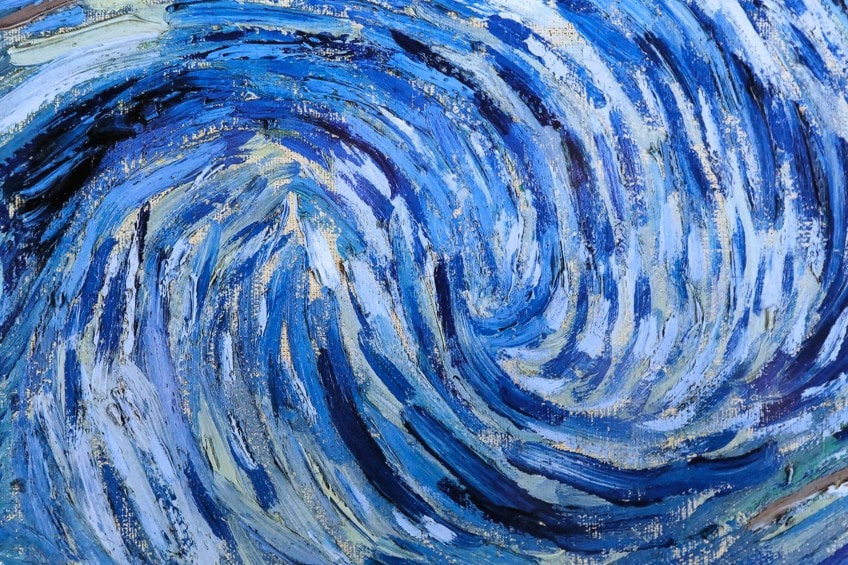 A item of the swirls in The Starry Dark (1889) by Vincent van Gogh; Frank Vincentz, Public domain, via Wikimedia Commons
A item of the swirls in The Starry Dark (1889) by Vincent van Gogh; Frank Vincentz, Public domain, via Wikimedia Commons
Van Gogh creates a sense of movement with choppier white lines as the heaven meets the mountains in the background – these seemingly move in unison as the mountain range becomes increasingly flatter. The white swathes appear like snow or fog creating a blanket over the hilltops, every bit making the hilltops announced rhythmic. We run across this result in the brushstrokes delineating the Cypress tree in the foreground. Van Gogh brings the entire composition to life with the style he applies color and brushstrokes.
If we await at each star, and the moon, there is an aura of yellow and white surrounding it. Some are painted in white and others yellow, but we discover that van Gogh uses these colors in combination, which also creates softer tones of xanthous, peculiarly effectually the crescent-shaped moon.
This also points to van Gogh'due south utilization of complementary colors and his cognizance of these formal elements that brand a painting.
Additionally, in The Starry Dark van Gogh also utilized darker hues of blue to create contrast. We see this in this starry dark background near the hillside, especially to the far correct in the middle footing where the hilltop meets the sky. This appears well-nigh black in color, which is juxtaposed with that foggy white swath of the heaven that nosotros mentioned higher up.
 A detail of The Starry Night (1889) by Vincent van Gogh; Vincent van Gogh, Public domain, via Wikimedia Commons
A detail of The Starry Night (1889) by Vincent van Gogh; Vincent van Gogh, Public domain, via Wikimedia Commons
The moon itself is a brighter shade of yellow and there is another star to the left of the limerick that is also in a brighter yellow, it lies directly across from the moon. This star is Venus, the Morning Star. It is believed that van Gogh witnessed the Venus star in the forenoon while staring out of his window. In 1 of the letters to his brother Theo, Letter 777 (1889), van Gogh wrote:
"This morning time I saw the countryside from my window a long fourth dimension before sunrise with nil but the morning star, which looked very large."
The application of colors and brushstrokes creates a moving textural composition and a report of the night. In fact, van Gogh referred to this painting every bit a "Night effect" in one of his letters to Theo (Letter of the alphabet 806, 1889). Van Gogh sent his "Night event" along with another "consignment of canvases".
Perspective and Space
Van Gogh's The Starry Night is a rich combination of vertical, horizontal, diagonal, and circular lines, made from the utilization of thick brushstrokes and outlines. As we take stated, these create a sense of movement and quite visibly create a whole new perspective, one that is flowing and seemingly of another earth, some would depict the painting equally almost hallucinogenic.
Perspective is further highlighted past the looming verticality of the Cypress tree in the foreground. We see this verticality echoed in the steeple of the church in the near distance, which gives the impression of depth.
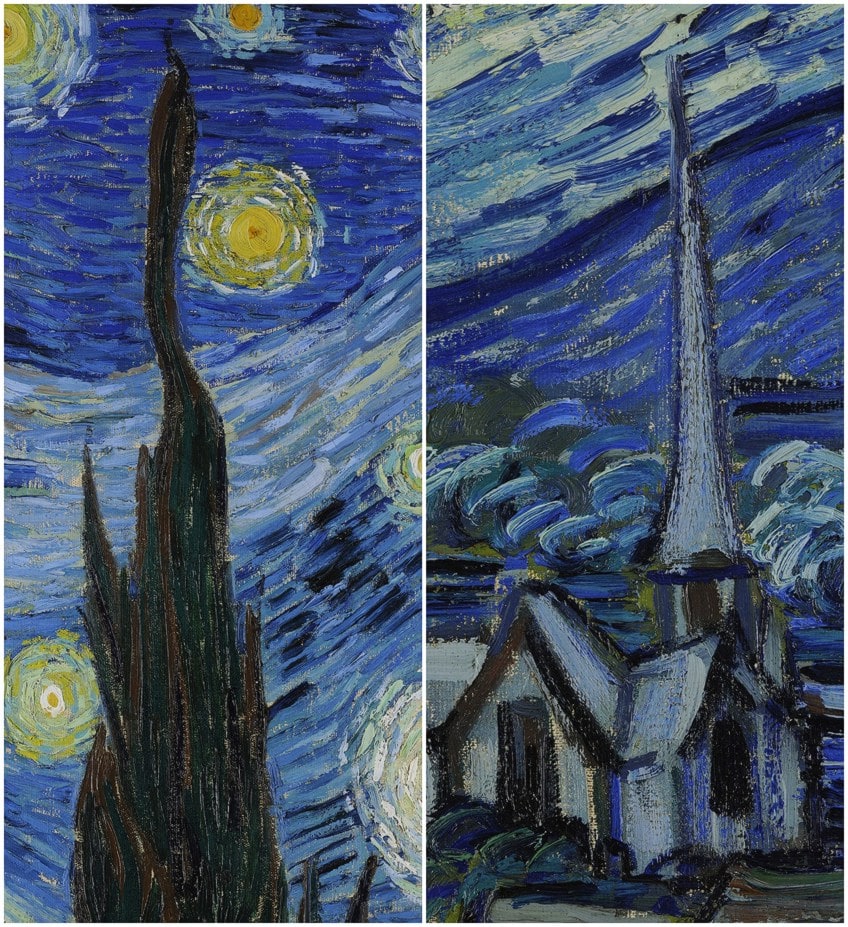 The verticality of the Cypress tree (left) is reflected in that of the steeple of the church (right), from The Starry Night (1889) by Vincent van Gogh; Vincent van Gogh, Public domain, via Wikimedia Commons
The verticality of the Cypress tree (left) is reflected in that of the steeple of the church (right), from The Starry Night (1889) by Vincent van Gogh; Vincent van Gogh, Public domain, via Wikimedia Commons
This perspective plays directly with the spatial aspects of the composition, and the large expanse of the sky makes the village appear smaller and almost not as pregnant as the sky above, which seemingly takes precedence.
However, this is understandable every bit van Gogh's intention seemed to be rooted in studying the night sky and how to stylistically depict this.
Symbolism and Style
There are several ideas around The Starry Dark meaning. Some believe van Gogh painted The Starry Nighttime as a symbol of his inner turmoil, especially regarding the Cypress tree in the foreground, which supposedly symbolizes expiry. Withal, it is suggested he painted the Cypress tree for the purposes of stylistic report and not so much for the inherent cultural significant of it.
Van Gogh mentioned studying the depiction of Cypress trees just like he has with wheatfields, in one of his letters to Theo. In Letter 783, 1883, he wrote about ideas he had and that a "wheatfield or a cypress are well worth the effort of looking at them from close at paw". He further explained about the Cypress tree, saying:
"[they] still preoccupy me; I'd like to practice something with them like the canvases of the sunflowers because it astonishes me that no 1 has all the same done them every bit I see them."
 A detail of the Cypress tree in The Starry Night (1889) by Vincent van Gogh; Vincent van Gogh, Public domain, via Wikimedia Eatables
A detail of the Cypress tree in The Starry Night (1889) by Vincent van Gogh; Vincent van Gogh, Public domain, via Wikimedia Eatables
In The Starry Night, van Gogh shows united states his personal expression even though this is a night report of the natural environment. This touches on his stylistic experimentations of the time. Information technology also includes how his colleagues like Gauguin approached painting because while van Gogh was more than inclined to paint scenes en plein air, Gauguin painted more abstracted artworks.
This was a matter of question for van Gogh every bit he also wrote near it in one of his letters to some other colleague, Émile Bernard, where he explained that he "allowed" himself to be "led astray into abstraction" when Gauguin and he lived and worked together.
He further explained that his painting was a failure, saying that he "once again" allowed himself to be "led off-target into reaching for stars that are likewise big".
Theo van Gogh also commented on The Starry Night and Vincent'southward veer towards a somewhat different style. He remarked in ane of his letters (Letter of the alphabet 813, 1889): "I clearly sense what preoccupies you lot in the new canvases like the village in the moonlight or the mountains, but I feel that the search for style takes away the real sentiment of things". He so continued that he could see the "same preoccupations" with Gauguin'south paintings, which just showed more "memories of the Japanese, the Egyptians, etc."
Ultimately, Vincent van Gogh's The Starry Nighttime painting has been the topic of numerous fine art historical postulations and many point to this painting equally being a symbol of van Gogh'south expression of a higher realm of existence.
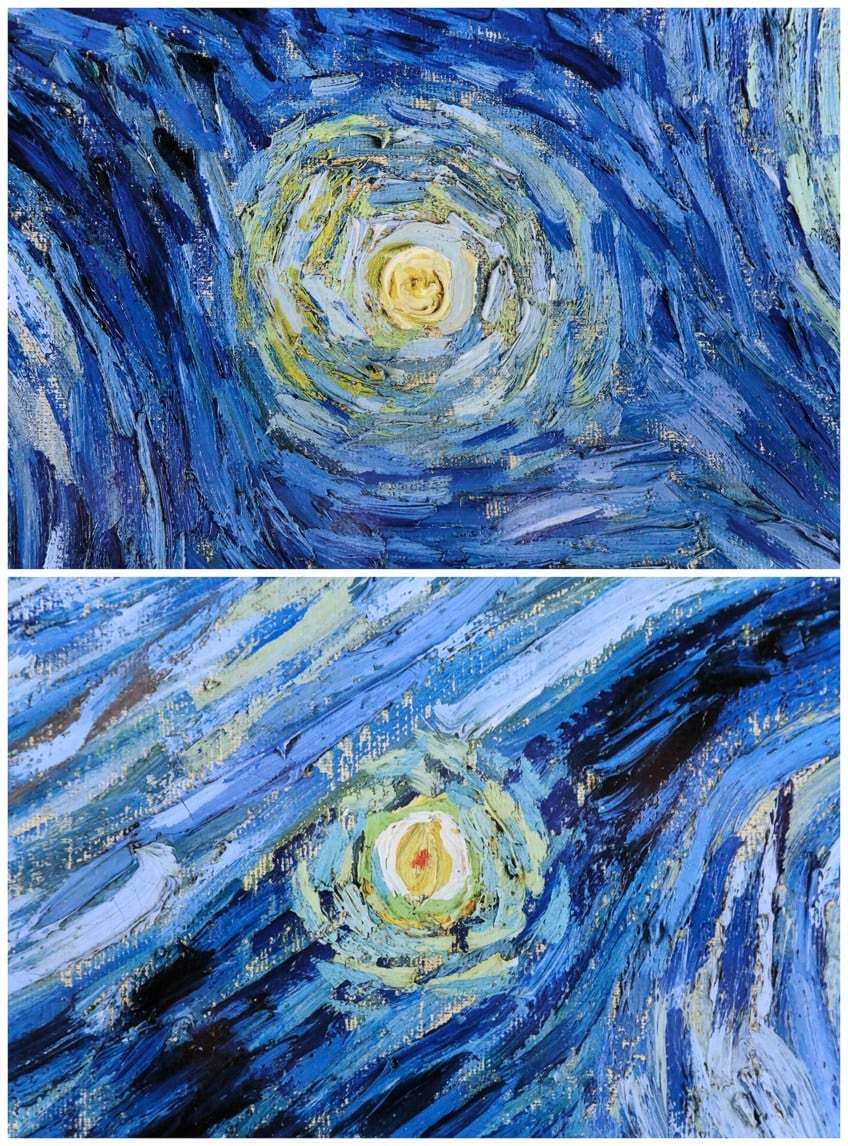 The stars and swirls of Vincent van Gogh's The Starry Night (1889); TOP:Frank Vincentz, Public domain, via Wikimedia Eatables | BOTTOM: Frank Vincentz, Public domain, via Wikimedia Eatables
The stars and swirls of Vincent van Gogh's The Starry Night (1889); TOP:Frank Vincentz, Public domain, via Wikimedia Eatables | BOTTOM: Frank Vincentz, Public domain, via Wikimedia Eatables
The swirls have been believed to exist van Gogh'due south delineation of the cosmos as well every bit possibly the wind. Martin Bailey, a reporter who is also known as a specialist on Vincent van Gogh, has presented the theory that the artist was inspired past the waves we see in the Japanese painter, Katsushika Hokusai's woodblock print called The Swell Wave off Kanagawa (1831).
Apparently, van Gogh was an avid gentleman of the Japanese style and a collector of Japanese art. This is besides important because during the middle of the 1800s up to the early 1900s, the Japonism mode, particularly the Ukiyo-e Japanese woodblock prints, was significantly influential in European art styles.
Van Gogh and many other artists from the Impressionist movement were influenced by it, particularly how perspective and infinite were utilized as well as how colors were applied in bright tones.
Not to Be Confused With the Other Starry Night
Vincent van Gogh painted the above-mentioned The Starry Night in 1889, withal, this is part of a series of other Vincent van Gogh paintings of dark scenes by the creative person, these are typically known as the Nocturne series. He painted Starry Night Over the Rhȏne in 1888. This version is the River Rhȏne in Arles.
In information technology we run into ii figures continuing in the foreground on the river bank. We too notice the loose use of brushstrokes and colors depicting how the lite from the city reflects on the river and nosotros encounter the yellow orbs of stars in the sky we have come to know then well from his later The Starry Night painting.
Van Gogh painted this starry night groundwork scene outside using the lite from a gas lamp. This is quite different from how he painted the later version, which was completely inside, in his art studio.
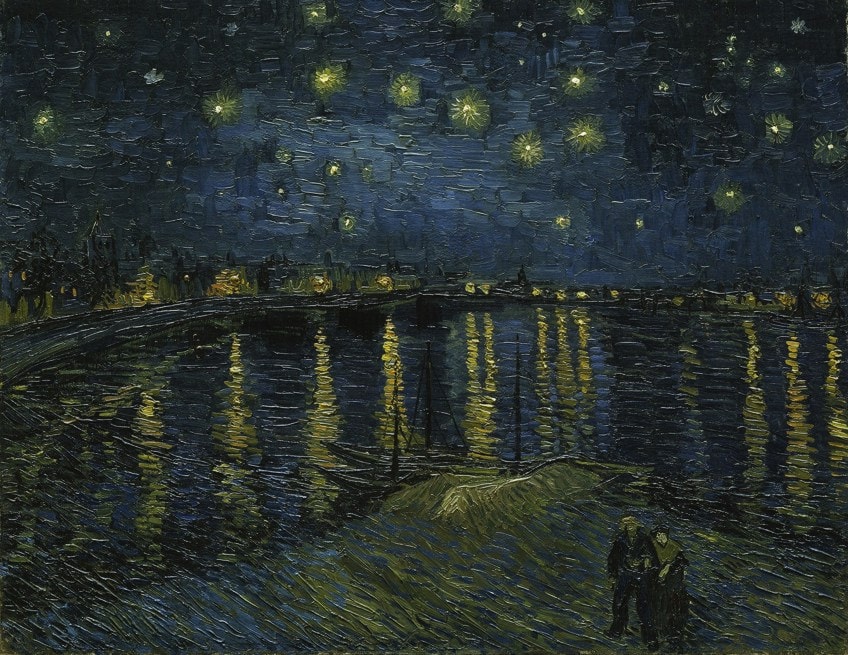 Starry Night Over the Rhȏne (1888) by Vincent van Gogh;Vincent van Gogh, Public domain, via Wikimedia Commons
Starry Night Over the Rhȏne (1888) by Vincent van Gogh;Vincent van Gogh, Public domain, via Wikimedia Commons
The other painting in van Gogh's night series is called Café Terrace at Nighttime (1888), which was also painted in Arles at the Place du Forum. Hither we see a view of a cafe to the left with the warm glow from the interior lighting. We also run across the illuminated night sky to a higher place with sparkling stars and the road below moving into darkness further ahead.
Van Gogh wrote about his composition and enthusiasm well-nigh painting the scene at night in one of his letters to Willemien van Gogh, his sis. In Alphabetic character 678, 1888, he explains the colors he utilized to paint the darkness, "Now there'due south a painting of night without black. With nothing but beautiful blue, violet, and green, and in these surroundings the lighted square is colored pale sulfur, lemon green. I enormously enjoy painting on the spot at night". In the same letter of the alphabet, van Gogh likewise mentioned his eagerness almost painting the starry sky adjacent, as this was 1 of his earlier night scenes. He explains:
"I definitely want to paint a starry sky at present. It ofttimes seems to me that the night is even more richly colored than the mean solar day, colored in the virtually intense violets, dejection, and greens".
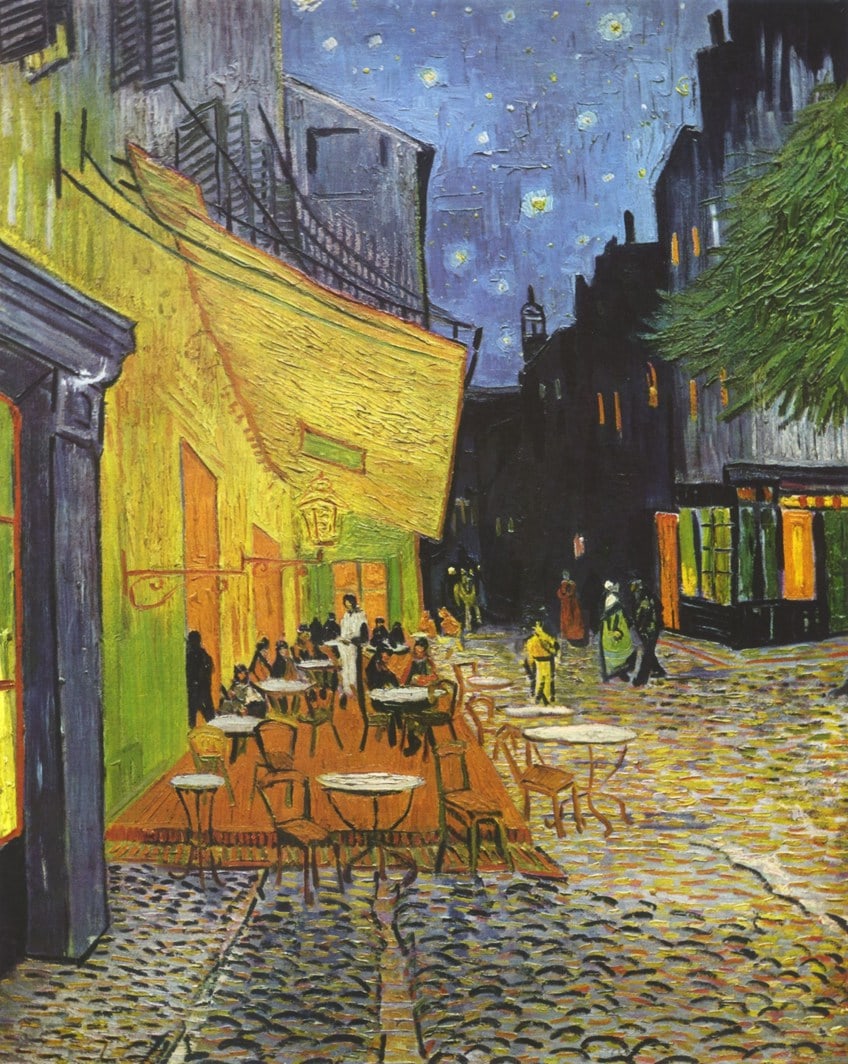 Café Terrace at Dark (1888) past Vincent van Gogh;Vincent van Gogh, Public domain, via Wikimedia Commons
Café Terrace at Dark (1888) past Vincent van Gogh;Vincent van Gogh, Public domain, via Wikimedia Commons
This is a testament to how van Gogh enjoyed experimenting with different colors to achieve the effects of non simply different types of light at night, whether natural or bogus every bit we see from within the café but daylight likewise. He also painted from the natural environment around him, testament again to the Impressionistic mode, however, he combined this en plein air approach with his emotions and how he experienced these surroundings.
Reaching for the Stars
Vincent van Gogh created hundreds of paintings and sketches throughout his life as an artist, merely he did not achieve wide success similar other artists. Only later on his death did he go popular, and sometimes his paintings even stole the evidence, The Starry Dark (1889) discussed in the commodity higher up was i of them. Now considered a masterpiece from the Post-Impressionism art movement, The Starry Dark is the star of the show and a 21st-century popular cultural scene easily spotted on memorabilia ranging from mugs to magnets.
Vincent van Gogh did non accept an like shooting fish in a barrel life, he experienced considerable mental challenges and struggles that undoubtedly affected the way he made his fine art, and perhaps even enhanced his own personal style. He was a man deeply devoted to depicting beautiful scenes of the natural world in rich textures and colors that not only showed his expressive artistic style, merely also his inner world.
This inner globe was seemingly just like his use of complementary colors, a mix of inner turmoil, only non without a mix of his sincere appreciation of the beauty of the earth he experienced during the day and night. Vincent van Gogh was sadly his own victim, committing suicide in the stop and leaving all his artwork to his brother Theo van Gogh, simply it was his collection of artworks that continued his legacy and lives on for him.
Take a look at our The Starry Nighttimepainting webstory here!
Frequently Asked Questions
Who Painted The Starry Night?
The Starry Night (1889) painting is a famous oil painting by Vincent van Gogh, who was part of the Post-Impressionism fine art motion during the 19th century.
Where Was The Starry Night Painted?
The Starry Dark (1889) was painted while Vincent van Gogh was staying at the mental establishment called Saint-Paul-de-Mausole in the boondocks chosen Saint-Rémy-de-Provence, which is in France. Many sources suggest van Gogh painted this scene from memory, imagination, and other works of fine art. It was likewise painted in his studio at the asylum, which did not have a view of the mountains. However, his bedroom window, which was in a carve up room, had a view of the mountains.
How Many Starry Night Paintings Are In that location?
Vincent van Gogh completed two paintings with similar titles depicting dark scenes (although at that place were others exploring the nighttime). His first rendition was chosen Starry Night Over the Rhône (1888), which was a delineation of the Rhône River located in Arles where van Gogh lived at the time. However, this painting should non be dislocated with another titled The Starry Night (1889), which was when the artist lived in the mental asylum in Saint-Rémy-de-Provence.
Where Is The Starry Night Painting Housed?
The 1889 version of The Starry Nighttime by van Gogh is at present housed in the Museum of Modernistic Art (MOMA) in New York City. The Starry Night original painting was initially in Theo van Gogh's possessions and and so later on Theo's expiry, it was the holding of his wife. Through unlike hands, The Starry Night somewhen plant its style to the French art dealer Paul Rosenberg, from whom the MOMA acquired it in 1941.
How Much Is The Starry Nearlyt Worth?
The Starry Night original painting by Vincent van Gogh, painted in 1889, is estimated to be worth over $100 million. However, this painting is one of van Gogh's masterpieces and it tin can also be argued that there cannot be a price for it – it is priceless.
Source: https://artincontext.org/starry-night-van-gogh/
0 Response to "Impressionist Art Romantisism Erea What Year Was Starry Night Created"
Postar um comentário